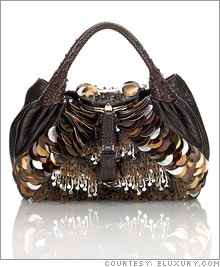Rich, online, and nowhere to buyOnline retailers are the wave of the future, so why are the world's trendsetting luxury brands so far behind?NEW YORK (CNNMoney.com) -- Shoppers are willing to spend more money than ever online, but when it comes to finding luxury goods on the Web, they're getting shortchanged. Looking for the latest Prada bag? You won't find it at Prada.com. Your best bet is to scour the limited selections at high-end retailers like saksfifthavenue.com or bergdorfgoodman.com. Crazy for Chanel? Sorry again. You'll have to head to a company store.
Indeed, while many luxury brands have their own Web sites, the best most shoppers can usually hope for is information on where to find a physical store. Very few sites actually sell anything. The dearth of high-end goods online is surprising. Luxury retailers tend to be the leaders in retail innovation and their customers are often Internet-savvy, time-constrained spendthrifts who crave convenience. So what gives? For one thing, luxury brands have long been concerned that an online presence cheapens their image. It's a perception rooted in the early days of the Web, when bargains at retail sites like eBay (Charts, Fortune 500) and Amazon.com (Charts, Fortune 500) were the norm, said Matt Marcus, Gucci's worldwide director of e-business. "Luxury firms are afraid to provide that convenience online because they don't think it's a luxury experience," added Milton Pedraza, chief executive of the Luxury Institute, a research firm based in New York. "But what they don't realize is that wealthy consumers don't want the in-store experience, they want convenience." High-end retailers are missing out on a big opportunity. This year consumers will spend an estimated $260 billion online, including travel-related buys, according to a joint report from the National Retail Federation and Shop.org. Of that, some $22 billion will be spent on clothing, accessories and footwear, a 20 percent increase from 2006. The case for courting online shoppers with a taste for the high life is compelling. Fully 99 percent of affluent consumers are online, according to the Luxury Institute, and they've got cash to burn. Not only do affluent customers charge with abandon, but they also leave valuable information about their shopping habits and preferences - information that retailers crave. Sarah Logan, the director of merchandising for eLUXURY.com, an online boutique for luxury brands such as Louis Vuitton, Dior and Fendi, said limited-edition products that are hard to find in stores are often hot-sellers on the Web. "If it's the right item customers will spend the money," said Logan. eLUXURY, which launched seven years ago, is one of the few successful purveyors of luxury goods online. Coveted Fendi bags and Dior watches, which cost $4,000 to $5,000, often sell out within 24 hours, according to Logan. "The time-starved, convenience-minded wealthy consumers are buying everything on the Web that they are allowed to buy," said the Luxury Institute's Pedraza. The only thing holding them back, he said, is the lack of luxury items for sale. One study finds that the lack of a full-fledged e-commerce site can directly hurt a retailer's bottom line. Market research firm WebCollage recently found that 37 percent of shoppers who can't find what they're looking for on one company's site are likely to head to a competitor's site instead. The good news is, some luxury retailers are beginning to chase affluent customers online. Over the last five years, for instance, Gucci Group has overhauled its Web strategy by redesigning its site and adding a wide range of products that consumers can buy online. The site, which distinguishes itself from most shopping sites with a horizontal scroll bar and advanced zoom, manages to convey elegance and exclusivity. And unlike rivals, Gucci.com offers nearly all of its branded shoes, jewelry and accessories online, for prices ranging from $100 to $10,000. Today Gucci.com is one of the company's fastest growing segments, with sales up 65 percent in 2006 from the prior year. Frette, an Italian seller of high-end linens is also dressing up its online presence. Since Frette began selling its products directly online in November 2006, Web traffic to its site has spiked 300 percent. "The Web site is a great customer acquisition vehicle," said Cecilia Pagkalinawan, Frette's director of e-commerce. She noted that customers typically spend $100 to $15,000 online at one time (excluding one online shopper from Australia who dropped $36,000 on a chinchilla throw). But Frette isn't interested in luring customers online at the expense of its brick-and-mortar outlets. While Frette.com sells almost everything found in its retail stores, some items found online can only be bought at a physical location. The idea is to get shoppers to visit company stores. The strategy appears to be working. Frette has seen foot traffic to stores increase 10 to 15 percent in the seven months since the Web site was revamped, which Pagkalinawan attributed to Frette's broader online presence. It's clear that online shopping is much more than a fad. It's just surprising that the world's top trendsetters are the last to catch on. |
|

